Fifth Stalinist strike: operation "Bagration"
Situation at the front
By June 1944, the line of the Soviet-German front in the northeast reached the line Vitebsk - Orsha - Mogilyov - Zhlobin. At the same time, in the southern direction, the Red Army achieved tremendous success - the whole of Right-Bank Ukraine, the Crimea, Nikolaev, and Odessa were liberated. Soviet troops reached the state border of the USSR, began the liberation of Romania. Conditions were created for the liberation of all of Central and South-Eastern Europe. However, by the end of spring 1944, the Soviet offensive in the south slowed down.
As a result of the successes in the southern strategic direction, a huge ledge was formed — a wedge facing the depths of the Soviet Union (the so-called “Belarusian Balcony”). The northern end of the protrusion rested on Polotsk and Vitebsk, and the southern end - on the Pripyat River basin. It was necessary to eliminate the "balcony" to eliminate the possibility of a flank strike by the Wehrmacht. In addition, the German command redeployed considerable forces to the south, and the battles became protracted. The headquarters and the General Staff decided to change the direction of the main attack. In the south, the troops had to regroup, replenish the units with manpower and equipment, prepare for a new offensive.
The defeat of the Army Group Center and the liberation of the BSSR, through which the shortest and most important routes to Poland and major political, military-industrial centers and food bases (Pomerania and East Prussia) of Germany, were of tremendous military-strategic and political importance. The situation in the whole theater of operations in favor of the Soviet Union was changing radically. Success in Belarus was the best way to ensure our subsequent offensive operations in Poland, the Baltic States, Western Ukraine and Romania.
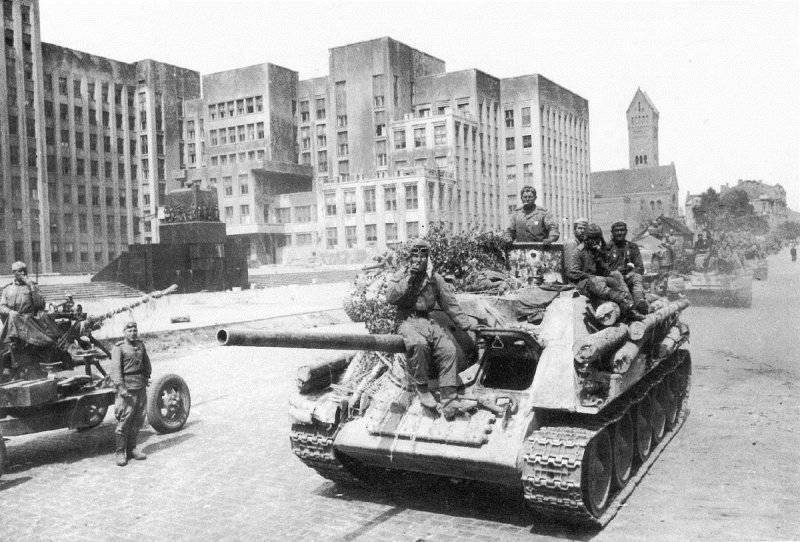
Su-85 column on Lenin Square in the liberated Minsk
Operation plan
In March 1944, the Supreme Commander invited Rokossovsky and announced the planned major operation, invited the commander to express his opinion. The operation was called "Bagration", this name was proposed by Joseph Stalin. According to the Headquarters, the main actions of the summer campaign of 1944 were to unfold in Belarus. For the operation, it was supposed to attract the forces of four fronts: the 1st Baltic, 1st, 2nd and 3rd Belorussian fronts. The Dnieper military was also involved in the Belarusian operation flotilla, aviation long-range and partisan detachments.
In late April, Stalin made a final decision about the summer campaign and the Belarusian operation. Alexei Antonov, Chief of the Operations Directorate and Deputy Chief of the General Staff, was instructed to organize work on planning front-line operations and begin to concentrate troops and material resources. So, the 1st Baltic Front under the leadership of Ivan Baghramyan received the 1st tank Corps, 3rd Belorussian Front of Ivan Chernyakhovsky - 11th Guards Army, 2nd Guards Tank Corps. In addition, the 3th Guards Tank Army (reserve Headquarters) was concentrated in the offensive zone of the 5rd Belorussian Front. The 1th Army, the 28th Tank and 9st Guards Tank Corps, the 1st Mechanized Corps and the 1th Guards Cavalry Corps were concentrated on the right flank of the 4st Belorussian Front.
In addition to Antonov, only a few people, including Vasilevsky and Zhukov, were involved in directly developing the plan for Operation Bagration. Subject correspondence, telephone or telegraph negotiations were strictly prohibited. One of the priorities in the preparation of the Belarusian operation was its secrecy and misinformation of the enemy regarding the planned direction of the main attack. In particular, the commander of the 3-th Ukrainian Front, Army General Rodion Malinovsky, was instructed to conduct a demonstrative concentration of troops behind the right flank of the front. A similar order was received by the commander of the Baltic Front 3, Colonel-General Ivan Maslennikov.

Aleksey Antonov, Deputy Chief of the General Staff of the Red Army, Lead Developer of the Belarusian Operation Plan
On May 20, Vasilevsky, Zhukov and Antonov were summoned to GHQ. The plan for the summer campaign was finally approved. At first, the Leningrad Front (The fourth Stalinist blow: the defeat of the Finnish army). Then in the second half of June they planned to conduct an offensive in Belarus. Vasilevsky and Zhukov were responsible for coordinating the actions of the four fronts. Vasilevsky was entrusted with the 1 Baltic and 3 Belorussian fronts, Zhukov with the 1 and 2 Belorussian fronts. In early June, they departed for the deployment of troops.
According to the memoirs of K. K. Rokossovsky, the final offensive plan was worked out at the Headquarters 22-23 in May. The considerations of the command of the 1 Belorussian Front on the offensive of the forces of the left wing of the 1 Belorussian Front in the Lublin sector were approved. However, the idea that the troops of the right flank of the front should deliver two main blows at once was criticized. Members of the Headquarters believed that it was necessary to deliver one main blow in the direction of Rogachev - Osipovichi, in order not to disperse forces. Rokossovsky continued to stand his ground. According to the commander, one blow was needed from Rogachev, the other from Ozariches to Slutsk. At the same time, the Bobruisk enemy grouping fell into the “cauldron”. Rokossovsky knew the terrain well and understood that the movement of the left flank armies in one direction in a heavily marshy Polesie would result in an offensive, roads would be blocked, front forces would not be able to use all of their capabilities, as they would be introduced into the battle in parts. After making sure that Rokossovsky continued to defend his point of view, Stalin approved the plan of the operation in the form proposed by the headquarters of the 1 of the Byelorussian Front. I must say that Zhukov Rokossovskogo denies this story. According to him, the decision on two strikes of the 1 of the Belarusian Front was made by the Headquarters of the 20 of May.
31 May frontline commanders received the Bids directive. The aim of the operation was to cover two flank attacks and the destruction of the enemy group in the area of Minsk. Particular importance was attached to the defeat of the most powerful enemy flank groups that held defenses in the areas of Vitebsk and Bobruisk. This provided the opportunity for the rapid advance of large forces in the converging directions to Minsk. The remaining enemy troops were supposed to be thrown away to the area of action near Minsk that was unfavorable for them, cut off communications, surround and destroy them. The Stake Plan envisaged three heavy blows:
- The troops of the 1 Baltic and 3 Belorussian fronts struck in the general direction of Vilnius;
- forces of the 2 of the Belorussian Front, in cooperation with the left wing of the 3 of the Belorussian Front and the right wing of the 1 of the Belorussian Front, advanced in the direction of Mogilyov-Minsk;
- The connections of the 1 of the Byelorussian Front advanced in the direction of Bobruisk - Baranavichy.
At the first stage of the operation, the troops of the 1 Baltic and 3 of the Belorussian fronts were to defeat the enemy Vitebsk grouping. Then enter mobile units into the breakthrough and develop an offensive westward at Vilnius-Kaunas, with a coverage of the left flank of the Borisov-Minsk Wehrmacht group. The 2 Belarusian Front was supposed to destroy the Mogilev grouping of the enemy and advance on the Minsk direction.
At the first stage of the offensive, the 1 Belorussian Front was to destroy the enemy's Zhlobin-Bobruisk group by the forces of its right flank. Then enter into a breakthrough tank-mechanized formations and develop an attack on Slutsk-Baranavichy. Part of the forces of the front were to cover the enemy's Minsk grouping from the south and south-west. The left flank of the 1 of the Byelorussian Front struck at Lublin.
It should be noted that originally the Soviet command planned to strike at a depth of 300 km, defeat three German armies and reach the line of Uten, Vilnius, Lida, Baranavichy. The tasks for further offensive were set at the rate in mid-July, based on the results of the identified successes. At the same time, at the second stage of the Belarusian operation, the results were not so brilliant.
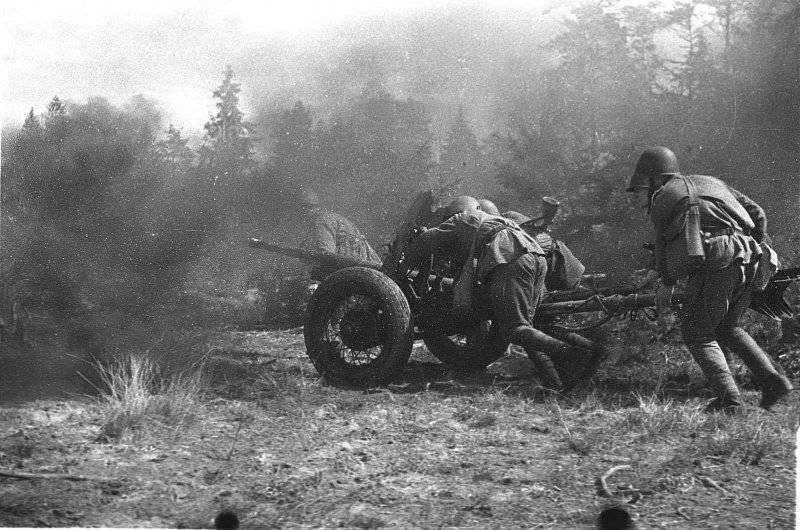
Fights for Belarus
Preparation of the operation
As Zhukov noted in his memoirs, to ensure the operation "Bagration", the troops needed to send up to 400 thousand tons of ammunition, 300 thousand tons of fuel and lubricants, up to 500 thousand tons of food and fodder. It was necessary to concentrate 5 combined arms armies, 2 tank and one air armies, as well as units of the 1 Army of the Polish Army in the given areas. In addition, the fronts were transferred from the reserve of Stakes 6 tank and mechanized corps, more than 50 rifle and cavalry divisions, more than 210 thousand marching replenishment and more than 2,8 thousand guns and mortars. It is clear that all this had to be transferred and transported with great precautions so as not to reveal to the enemy the plan of a grandiose operation.
Particular attention was paid to disguise and secrecy and the course of the immediate preparation of the operation. Fronts switched to radio silence mode. Excavation work was conducted on the front lines, which imitated the strengthening of defense. Concentration of troops, their transfer was conducted mainly at night. Soviet aircraft even patrolled the area to monitor measures to comply with masking measures, etc.
Rokossovsky in his memoirs pointed to the great role of intelligence in the front line and in the rear of the enemy. The command paid special attention to air, military, all types and radio intelligence. Only in the armies of the right flank of the 1 of the Byelorussian Front more 400 searches were conducted, Soviet intelligence officers captured more 80 "languages" and important documents of the enemy.
14-15 June, the commander of the 1 Belorussian Front conducted training sessions for the upcoming operation at the headquarters of the 65 and 28 armies (right wing of the front). The headquarters game was attended by representatives of the Headquarters. The commanders of corps and divisions, the commanders of artillery and the chiefs of the branches of armies of the armies were drawn to the rally. In the course of the training, questions of the upcoming offensive were worked out in detail. Particular attention was paid to the nature of the terrain in the zone of advance of the armies, the organization of the enemy's defense and the methods of speedy breakthrough on the Slutsk-Bobruisk road. This made it possible to close the withdrawal paths of the Bobruisk grouping of the adversary’s 9 Army. In the following days, similar classes were held in the 3, 48 and 49 armies.
At the same time, a large training and political training of the Soviet troops was carried out. In the classroom, fire missions, tactics and attack techniques, an offensive in cooperation with tank and artillery units, with the support of aviation, were worked out. The headquarters of the units, formations and armies worked out the issues of control and communication. Command and observation posts were advanced, created a system of observation and communication, clarified the order of movement and control of troops during the pursuit of the enemy, etc.
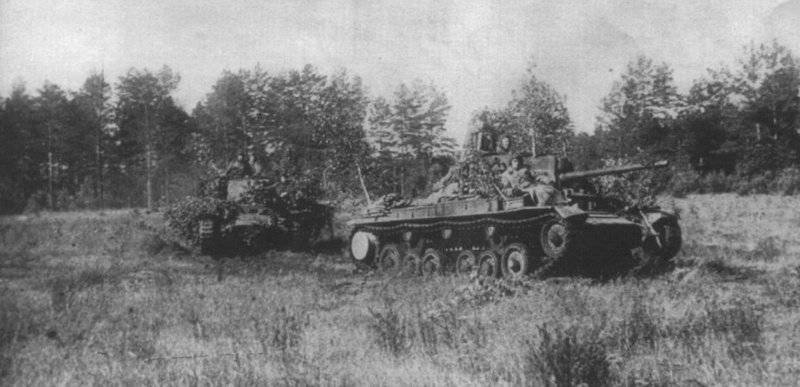
Soviet tanks "Valentine IX" put forward to combat positions. 5-I Guards Tank Army. Summer 1944 of the year
The Belarusian headquarters of the partisan movement provided great assistance in the preparation of an offensive operation. A close relationship was established between the partisan detachments and the Soviet troops. The guerrillas received instructions from the “big land” with specific tasks, where and when to attack the enemy, what communications to destroy.
It should be noted that by the middle of 1944, partisan detachments operated in most of the BSSR. Belarus was a real partisan region. There were 150 partisan brigades and 49 individual detachments totaling a whole army in the republic - 143 thousand bayonets (almost 200 thousand partisans joined the Red Army during the Belarusian operation). The guerrillas controlled vast territories, especially in wooded and marshy areas. Kurt von Tippelskirch wrote that the 4 Army, which he commanded from the beginning of June 1944, turned out to be in a huge wooded and swampy area that extended to Minsk and the area was controlled by large partisan units. For all three years, German troops have never been able to completely clear this territory. All the ferries and bridges in this remote area, covered with dense forests, were destroyed. As a result, although the German troops controlled all major cities and railway junctions, up to 60% of the territory of Belarus was under the control of Soviet partisans. Here, as before, Soviet power existed, the regional committees and district committees of the Communist Party and the Komsomol (the All-Union Leninist Communist Youth Union) worked. It is clear that the guerrilla movement could be maintained only with the support of the "big land", from where experienced cadres were thrown, weapon and ammunition.
The offensive of the Soviet armies was preceded by an unprecedented scale attack by partisan units. On the night of 19 on 20 June, partisans began a massive action to defeat the German rear. The guerrillas destroyed the enemy’s railway communications, blew up bridges, set up ambushes on the roads, and disrupted communication lines. Only on the night of June 20, was the 40 thou. Thousand enemy rails eroded. Eike Middeldorf noted: “On the central section of the Eastern Front, Russian partisans produced 10500 explosions” (Middeldorf Eike. Russian campaign: tactics and armament. - SPb., M., 2000). The guerrillas were able to carry out only part of the plan, but this was enough to cause a brief paralysis of the rear of Army Group Center. As a result, the transfer of German operational reserves was delayed for several days. The message on many highways became possible only in the afternoon and only accompanied by strong convoys.
Forces of the parties. Soviet Union
Four fronts combined 20 combined arms and 2 tank armies. Total 166 divisions, 12 tank and mechanized corps, 7 fortified areas and 21 separate brigade. About one-fifth of these forces were included in the operation at its second stage, approximately three weeks after the start of the offensive. At the start of the operation, Soviet troops numbered about 2,4 million soldiers and commanders, 36 thousand guns and mortars, more than 5,2 thousand tanks and SPGs and more than 5,3 thousand aircraft.
The 1 Baltic Front of Ivan Bagramyan included: the 4 th shock army under the command of P. F. Malyshev, the 6 th guards army of I. M. Chistyakov, the 43 th army of A. Beloborodov, the 1 th tank Corps V. V. Butkov. From the air, the front was supported by NF Papivin's 3 Air Army.
The 3 Belarusian Front of Ivan Chernyakhovsky consisted of: I. I. Lyudnikov's 39 Army, N. I. Krylov's 5 Army, K. N. Galitsky 11 Guards Army, V. V 31 Army. Glagoleva, 5 of the Guards Tank Army of P. A. Rotmistrov, 2 of the Guards Tank Corps of AS Burdeyno, equestrian group N.S. Oslikovsky (it included 3 of the Guards Corps and 3) Guards Mechanized Corps). From the air, the troops of the front were supported by the M. M. Gromov's 1 Air Army.
The 2 th Belorussian Front of George Zakharov included: the 33 th army of V.D. Kryuchyonkin, the 49 th army of I. T. Grishin, the 50 th army of I. V. Boldin, the 4 th air army of K. A Vershinina.
1 of the Belarusian Front of Konstantin Rokossovsky: 3-I Army A. V. Gorbatov, 48-I Army P. L. Romanenko, 65-I Army P. I. Batova, 28-I Army A. A. Luchinsky, 61- I am the army of P. A. Belov, the 70-I army of V. S. Popov, the 47-I army of N. I. Gusev, the 8-I guards army of V. I. Chuikov, the 69-I army of V. Ya. Kolpakchi, 2 I tank army S. I. Bogdanov. The front also included 2, 4 and 7 Guards cavalry corps, 9 and 11 tank corps, 1 Guards tank corps, 1 motorized corps. In addition, the 1 Army of the Polish Army Z. Berling and the Dnieper military flotilla of Rear Admiral V. V. Grigoriev were subordinate to Rokossovsky. The front was supported by the 6-I and 16-I air armies of F. P. Polynin and S. I. Rudenko.
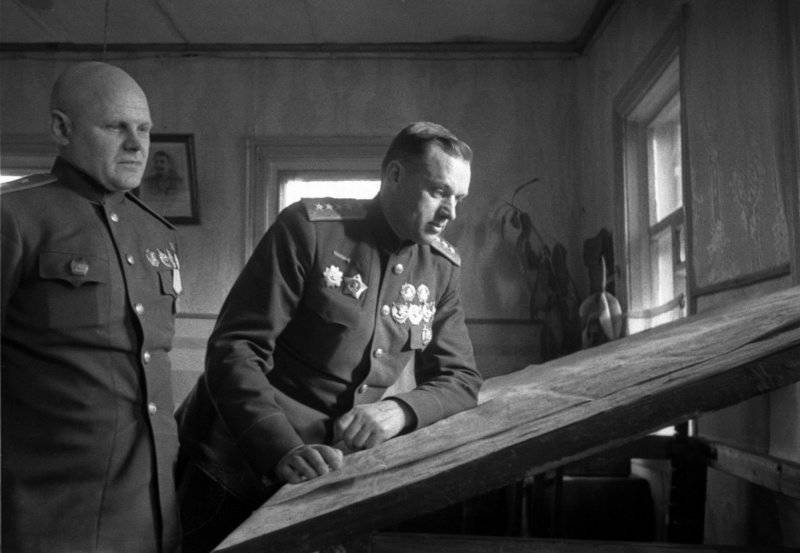
Member of the Military Council of 1 of the Belorussian Front, Lieutenant General Konstantin Fedorovich Telegin (left) and Army Front Commander Army General Konstantin Rokossovsky at the map at the front command post
German Forces
Soviet forces were opposed by Army Group Center under the command of Field Marshal Ernst Bush (from 28 Jun Walter Model). The group of armies included: 3-I tank army under the command of Colonel-General Georg Reinhardt, 4-I army Kurt von Tippelskirch, 9-I army Hans Jordan (27 June was replaced by Nikolaus von Forman), WNtera 2-I army, 6-I was replaced by Wärtera, and 1-I Värte Värte. ). Army Group "Center" was supported by aviation of the 4 th air fleet and partially of the 16 th and 4 th air fleets. In addition, in the north, the Army Group “Center was joined by the forces of the XNUMX Army of the Army Group North, and in the south by the XNUMX Panzer Army of the Army Group Northern Ukraine.
Thus, the German troops consisted of 63 divisions and three brigades; 1,2 million soldiers and officers, 9,6 thousand guns and mortars, more than 900 tanks and assault guns (according to other 1330 data), 1350 combat aircraft. The German armies had a well-developed system of railways and highways, which made it possible to maneuver the troops widely.
German command and defense plans
The Belarusian Balcony closed the road to Warsaw and further to Berlin. When the Red Army went over to the offensive in the northern and southern directions, the German group could deliver powerful flank attacks on Soviet troops from this "balcony". The German military command was mistaken about Moscow’s summer campaign plans. If the Stavka was quite well represented by the enemy forces in the area of the intended offensive, the German command believed that the Red Army could deliver only an auxiliary strike in Belarus. Hitler and the Supreme Command believed that the Red Army would once again launch a decisive offensive in the south, in Ukraine. The main blow was waited from the area of Kovel. From there, Soviet troops could cut off the "balcony", reaching the Baltic Sea and surrounding the main forces of the Army Group Center and North and dropping the Army Group Northern Ukraine to the Carpathians. In addition, Adolf Hitler feared for Romania — the Ploiesti oil region, which was the main source of “black gold” for the Third Reich. ” Kurt Tippelskirch noted: “The Center and North army groups were predicted to have a calm summer.”
Therefore, all in the reserves of the army group "Center" and the army reserves were 11 divisions. Of the 34 armored and motorized divisions that existed on the Eastern Front, the 24 was concentrated south of Pripyat. Thus, in the group of armies "Northern Ukraine" there were 7 tank and 2 tank-grenadier divisions. In addition, they were reinforced by 4 individual battalions of heavy tanks "Tiger".
In April, 1944, the command of Army Group Center, proposed cutting down the front line and taking the army to more comfortable positions across the Berezina River. However, the High Command, as before, when it was proposed to withdraw troops to more convenient positions in Ukraine or withdraw them from the Crimea, rejected this plan. Army Group was left in the same positions.
German troops occupied well-prepared and deeply echeloned (up to 250-270 km) defense. Building defensive lines began as early as 1942-1943, and finally the front line was formed during stubborn battles in the spring of 1944. It consisted of two lanes and relied on a developed system of field fortifications, resistance nodes - “fortresses”, numerous natural frontiers. Thus, defensive positions usually passed along the western banks of numerous rivers. Their crossing was hampered by wide marshy floodplains. The forested and marshy nature of the terrain, the multitude of reservoirs seriously worsened the possibilities for the use of heavy weapons. Polotsk, Vitebsk, Orsha Mogilev, Bobruisk were turned into “fortresses”, the defense of which was built with the possibility of all-round defense. The rear lines ran along the rivers Dnieper, Drut, Berezina, along the Minsk, Slutsk and further west. For the construction of field fortifications widely attracted local residents. The weakness of the German defense was that the construction of the defensive lines in depth was not completed.
In general, the Army Group "Center" covered the strategic East Prussian and Warsaw areas. Vitebsk direction covered the 3-I tank army, Orsha and Mogilev-3-I army, Bobruisk-9-I army. The front of the 2 Army passed along Pripyat. The German command paid serious attention to the replenishment of the divisions with manpower and equipment, trying to bring them to full-time strength. Each German division accounted for approximately 14 km of front. On average, 1 km of front had 450 soldiers, 32 machine guns, 10 guns and mortars, 1 tank or assault guns. But these are average numbers. They were very different in different parts of the front. Thus, on the Orsha and Rogachev-Bobruisk directions, the defense was stronger and more densely saturated with troops. In a number of other areas that the German command considered less important, the defensive orders were much less dense.
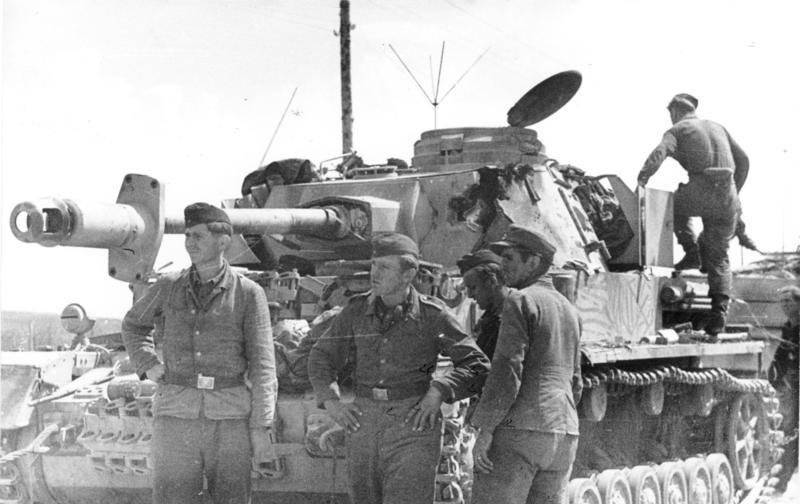
The 3-I tank army of Reinhardt occupied the line east of Polotsk, Bogushevskoe (about 40 km south of Vitebsk), having a front length of 150 km. The army included 11 divisions (8 infantry, two airfield, one guard), three brigades of assault guns, the von Gottberg combat group, 12 separate regiments (police, security, etc.) and other units. All divisions and two regiments were in the first line of defense. The reserve had 10 regiments, mostly they were engaged in the protection of communications and counterguerrilla struggle. The main forces defended the Vitebsk area. On 22 June, the army numbered more than 165 thousand people, 160 tanks and assault guns, more than 2 thousand field and anti-aircraft guns.
The Tippelskirkh 4 Army occupied defenses from Bogushevsk to Bykhov, having a front length of 225 km. It consisted of 10 divisions (7 infantry, one assault, 2 tank-grenadier - 25-I and 18-I), a brigade of assault guns, 501-th heavy tank battalion, 8 individual regiments and other parts. Already during the Soviet offensive, the Feldkhernhalle tanker-grenadier division arrived. The reserve was 8 regiments that performed the task of protecting the rear, communications and the fight against the guerrillas. The most powerful defense was on the Orsha and Mogilev directions. On 22 June, there were more than 4 thousand soldiers and officers in the 168 Army, around 1700 field and anti-aircraft guns, 376 tanks and assault guns.
Jordan's 9 Army defended itself in a strip south of Bykhov to the Pripyat River, having a front length of 220 km. The army included 12 divisions (11 infantry and one tank - 20-I), three separate regiments, 9 battalions (guard, sapper, construction). In the first line were all divisions, the regiment "Brandenburg" and 9 battalions. The main forces were located in the area of Bobruisk. The army reserve had two regiments. By the beginning of the Soviet offensive, the army had more than 175 thousand people, about 2 thousand field and anti-aircraft guns, 140 tanks and assault guns.
2-I army occupied the defense at the line of the river Pripyat. It consisted of 4 divisions (2 infantry, one ranger and one security), corps group, tank-grenadier brigade, two cavalry brigades. In addition, the 2 Army subordinated Hungarian 3 reserve divisions and one cavalry division. The reserve command of the army group had several divisions, including guard and training.
The Soviet command was able to maintain the preparation of a major offensive operation in Belarus until its very beginning. German aviation and radio intelligence usually noticed a major transfer of forces and concluded that the offensive was approaching. However, this time the preparation of the Red Army for the offensive was missed. Privacy and disguise did their job.
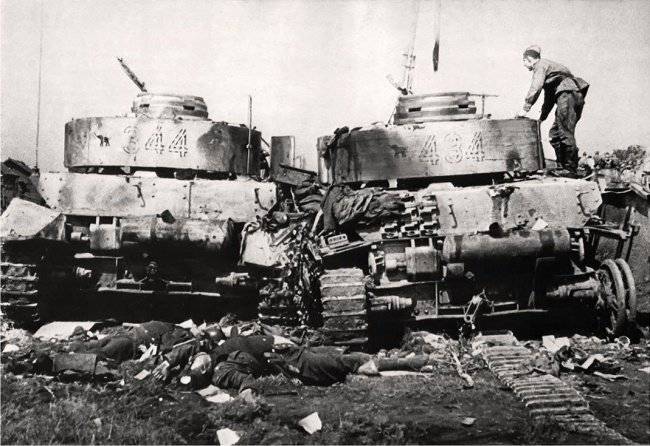
Wrecked tanks of the 20 Division in the area of Bobruisk (1944 year)
To be continued ...
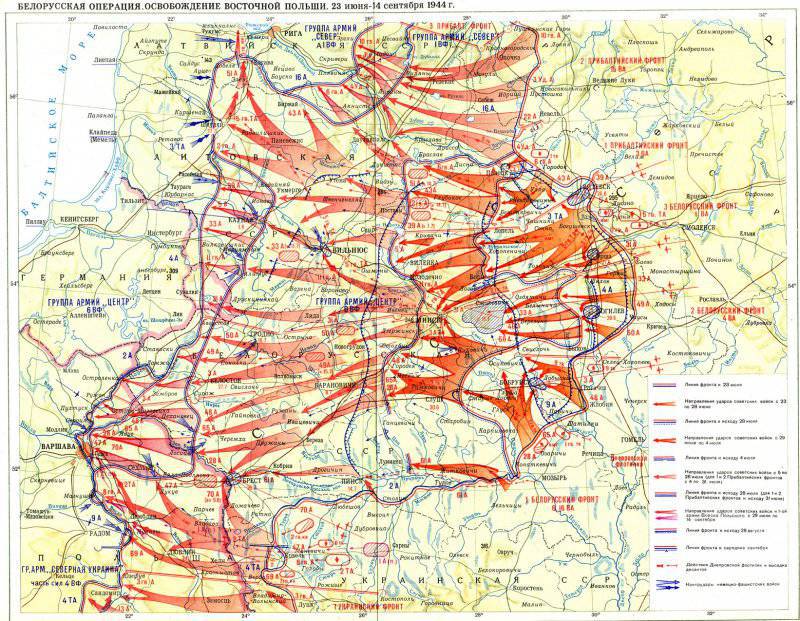
Information